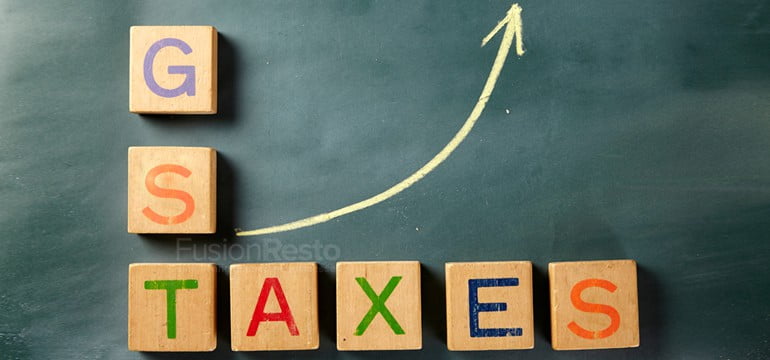F&B industry is one of the major contributors in boosting overall GDP of India. The tax differences in different states create a lot of hassles for vendors as well as owners of restaurants, bars, etc. GST is rolling out soon and with this Tax Reform, India is going to have a uniform tax across the states. The vendors will be able to sell stuff in any state and likewise, the businesses will be able to procure inventories from any state. Along with other impacts, GST will also simply the businesses and will bring the costs down for the owners as well as customers. The GST terms, GST rates, requirements for GST are still vague for most of us. With this editorial, we have tried to make GST simplified for Restaurants.
GST Simplified for Restaurants:
GST – Goods & Service tax
It is a destination-based tax on consumption of goods and services. It is proposed to be levied at all stages right from manufacture up to final consumption with credit of taxes paid at previous stages available as a setoff. In a nutshell, only value addition will be taxed and burden of the tax is to be borne by the final consumer. It would be a dual GST with the Centre and States simultaneously levying it on a common tax base
Dual GST
In India because of the no consensus between the central and state government, the proposal will introduce a Dual GST regime wherein tax would be jointly levied by both Centre and the states on the supply of goods and services.
The components of Dual GST are:
- CGST: Central Goods and Service Tax
- SGST: State Goods and Service Tax
- IGST: Integrated Goods and Service Tax
Taxes Subsumed under GST
- Central Excise
- Service Tax
- VAT / Sales Tax
- Entertainment Tax
- Luxury Tax
- Taxes on lottery
- Octroi and Entry Tax
- Purchase tax
GST Rates
- 0% tax – Commodities such as food grains, rice, and wheat are included.
- 5% tax – Products of mass consumption are included such as spices, tea and mustard oil.
- 12% tax – Processed food items has been included.
- 18% tax – Items such as soaps, oil, toothpaste, refrigerator, and smart phones have been included.
- 28% Tax – White goods and cars are included. Currently, whatever products are included in the 27-31% would be included in this tax bracket.
GSTIN
Stands for Goods & Service tax Identification number. It is a 15-digit PAN base code with following structure:
| GSTIN Format | Digit |
| State Code | 2 |
| PAN | 10 |
| Entity Code | 1 |
| Blank | 1 |
| Checksum Digit | 1 |
HSN/SAC Code
HSN Code – Harmonized System Nomenclature code number for Goods
SAC Code – Service Accounting Code for service item
ITC
Input Tax Credit means the availing of credit for input taxes paid
ITC Utilization:
| Input tax Credit | Set-Off against |
| CGST | CGST and IGST (in this order) |
| SGST | SGST and IGST (in this order) |
| IGST | IGST,CGST,SGST (in this order) |
GSTN
GSTN stands for Goods and Service Tax Network (GSTN). A Special Purpose Vehicle called the GSTN has been set up to cater to the needs of GST. The GSTN shall provide a shared IT infrastructure and services to Central and State Governments, taxpayers and other stakeholders for the implementation of GST.
The functions of the GSTN would include:
- Facilitating registration
- Forwarding the returns to Central and State authorities
- Computation and settlement of IGST
- Matching of tax payment details with banking network
- Providing various MIS reports to the Central and the State Governments based on the taxpayer return information
- Providing analysis of taxpayers’ profile
- Running the matching engine for matching, reversal and reclaim of input tax credit.
GSP
GST Suvidha Provider (GSP) is considered as an enabler for businesses to comply with the provisions of GST law through their GST Software. GSPs and ASPs thus will provide much needed support to taxpayers in the IT ecosystem for GST.
ASP
Application Service Providers (ASP) will focus on taking taxpayers’ raw data on sales & purchases and converting it into the GST returns. This GST return, or GSTRs, will then be filed on behalf of the filer with GSTN via the GSP. ASPs will act as a link between the taxpayers and the GSPs.
Copies of Tax Invoice required
Three copies of Tax Invoice is required for supply of goods
- Original for Recipient
- Duplicate for Transporter
- Triplicate for supplier
For supply of services, two copies required
- Original for Recipient
- Duplicate for Supplier
Place of Supply
It is the registered place of business of the recipient. Place of Supply’ under GST is an important factor as it defines whether the transaction will be counted as intra-state(i.e. within the same state) or inter-state(i.e. between two states) and accordingly the changeability of tax, i.e. levy of SGST, CGST & IGST will be determined.
Location of Supplier
It is the registered place of business of the supplier.
Time of Supply
Under GST the point of taxation will arise at the time of supply as determined for goods and services. The time of supply of goods shall be the following dates (whichever is earlier)–
- The date of issuing of invoice (or the last day by which invoice should have been issued)
- The date of receipt of payment
If you are an owner of Restaurant or Bar or any other kind of food joint, we are glad to announce that we have already made FusionResto Restaurant Management Software GST Enabled.
Do You want to know What will be the Impact of GST on Your Restaurant? Click here.
We have tried to simplify the GST for your restaurant with the details given above. Still, if you have any further queries about GST for Restaurants, please feel free to comment down below.







Leave a Reply
You must be logged in to post a comment.